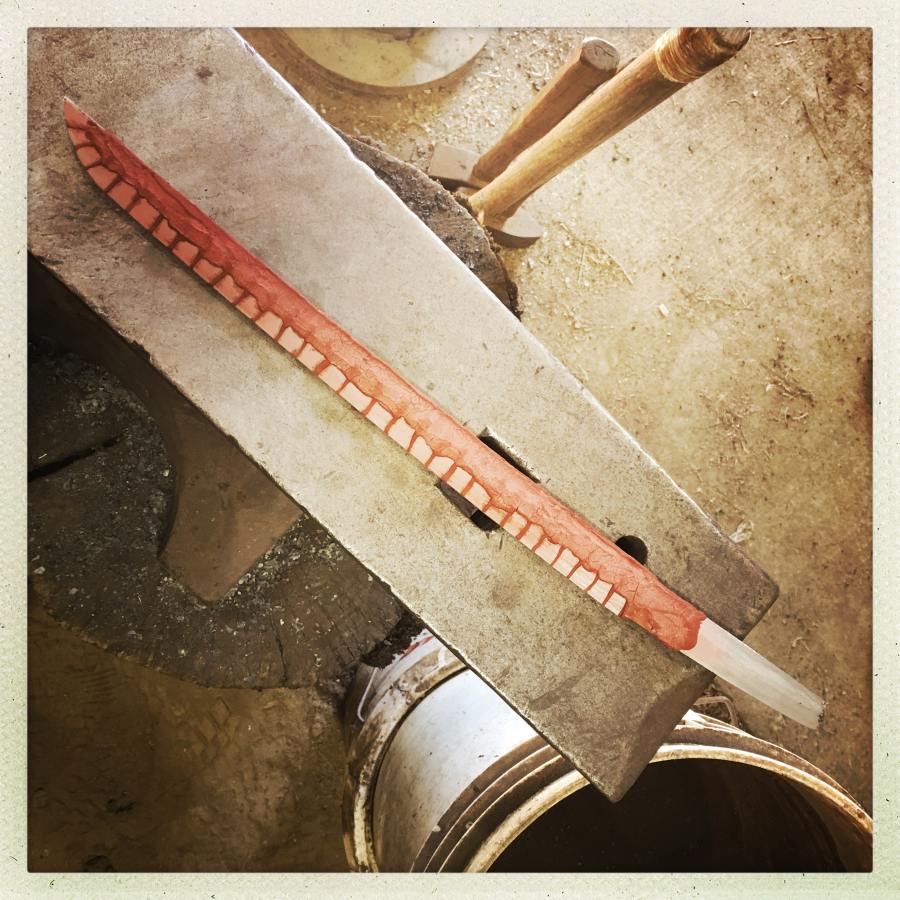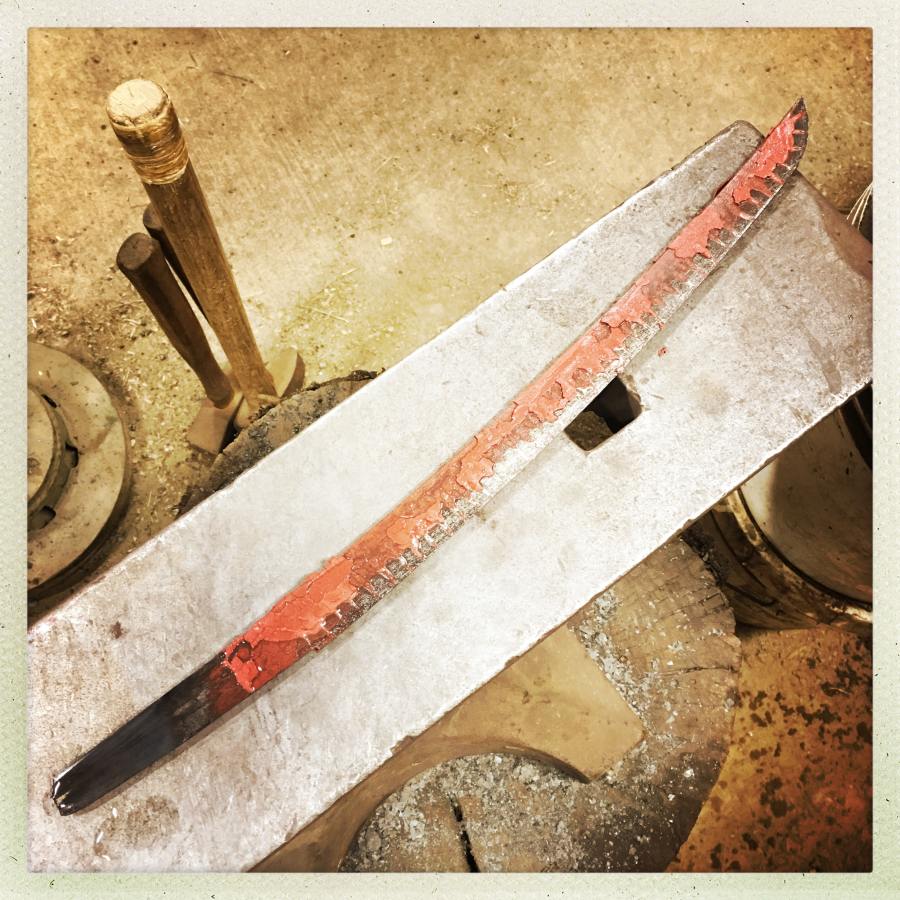The most dramatic moment in making a Japanese sword is the quenching. In part, that’s because if you have failures in your welds, the blade may suddenly delaminate, turn into a pretzel, or crack.
Japanese swords get their characteristic temper-line (Hamon) due to differential hardening of the steel – the leading edge of the blade is very hard because it is cooled quickly in water and it forms large martensite crystals; the back and sides are less hard because they are shielded with a layer of fire-clay that slows down the cooling.

Harder steel takes a sharper edge, and holds it longer, but it’s more brittle. The whole process is a way of tuning the blade’s internal crystallography and the stresses in the metal – quenching changes the curvature of the blade as you watch it, which is a bit nerve-wracking and very cool. Michael Bell keeps a blade in the studio that delaminated during quenching – it’s a pretty ugly thing – none of us want to see that happen to something we just spent days working on.
This is a bit of video I finally go around to editing, of Michael Bell quenching my wakizashi blade. A few notes:
- Up until about 0:26, he is moving the blade in and out of the forge to “soak” the heat through the steel as evenly as possible. If the steel is not evenly heated, there’s a much higher chance it’ll deform dramatically.
- At 0:29 when he heads over to the quenching trough, you can see he appears to be touching the yellow-hot metal with his left hand. He’s holding a small magnet, and is testing along the length of the blade to make sure the steel is demagnetized (“normalized”) – it goes into a form of Austenite, around 1500F, or 750C. The magnet is a good way of making sure it’s evenly heated, though Michael was mostly doing that to show us – at this point, he can tell steel temperature by looking at it.
- The trough of water is not cold; it’s about 130 degrees or so. To bring the trough up to temperature, Michael put a big steel block into the forge and got it red hot, then popped it into the trough to warm the water. If you quench a blade in cold water, you may over-stress it.
- At 0:48 you can clearly see the blade has taken on a different curvature.
The shock of going into the water blows most of the cement off the edge, but the cement on the sides and back stays long enough to slow the cooling.


Very cool! :D
Very hot! ;D
(sorry, couldn’t resist)
The amount of trial and error that went into developing such techniques must have been incredible, especially given that the people who did it lacked handy things like thermometers.
Now I find myself thinking it’s time to watch another of Ichikawa Raizo’s Nemuri Kyoshiro films.
A while back I watched a BBC documentary about one of the last remaining traditional Japanese family sword-making businesses… As I recall, they only partially quenched the blade in water, and then left it to finish cooling more slowly. The fascinating thing about that was that the blade was still straight coming out of the quench, and you got to watch it slowly taking on its final curve as it cooled. (The other really remarkable thing was that they did everything themselves in the traditional manner, starting with preparing the the iron ore.)
The full program doesn’t seem to be available, but there are a couple of clips (including the critical tempering) here: Handmade in Japan: The Samurai Sword.
Seems I’m mis-remembering: they don’t smelt their own steel.
timgueguen@#3:
The amount of trial and error that went into developing such techniques must have been incredible, especially given that the people who did it lacked handy things like thermometers.
Unbelievable amount of trial and error! And a lot of testing.
It still goes on (there’s a fun video by Walter Sorrels on youtube about metal-testing for knife-makers) – you’re dealing with a problem in nearly infinite trade-offs and there’s no “right” way for everything. Some of the analog tests are pretty disturbing – testing to see if the edge of a blade flexes by running it along a brass bar – it’s a great way to destroy days of work. But I suppose it’s better to destroy it in the shop and not where someone is depending on it.
Now I find myself thinking it’s time to watch another of Ichikawa Raizo’s Nemuri Kyoshiro films.
Those are so great.
I came across a fantastic movie the other day, which you should watch if you can find it. (Or I suppose I could be talked into eventually uploading an MP4 to someplace) – have you ever seen “After the Rain” (1999)? It’s not available in the US (the only copy I could find is French subtitled) but it’s amazing. The script is by Kurosawa but he never managed to make it; it’s shot by one of his old camera-men to make it look like it was made in the 1970s, it includes a cameo by Tatsuya Nakadai as a swordmaster (amazing!) and stars Akira Terao [wik]
Dunc@#4:
A while back I watched a BBC documentary about one of the last remaining traditional Japanese family sword-making businesses… As I recall, they only partially quenched the blade in water, and then left it to finish cooling more slowly.
Probably the Gassan family. The current sensei there is a “living national treasure.”
Michael Bell briefly pulled my blade out of the tank and then put it back in; same idea. I asked him about that and he says you have to learn to eyeball it. Oh, great. Walter Sorrels does some of his quenches in water then switches to oil in one second, which holds the heat near the metal longer and doesn’t convect it away as fast; it sort of anneals/tempers after the quench. Sorrels also says you learn to eyeball it. I think that what tends to happen is that each smith develops a process that works for them and “eyeballing it” becomes following the process.
(The other really remarkable thing was that they did everything themselves in the traditional manner, starting with preparing the the iron ore.)
There are some people who still do that, and Michael Bell had a few pieces of metal he smelted out of iron sand. It’s an insanely laborious process! Basically you make a giant single-use furnace/bonfire and ignite it, then when it cools you’ve got enough steel for a sword or maybe two. Iron sands steel is called tamaghane and .. it’s pricy. I don’t think it’s particularly good, and neither do most serious bladesmiths. If you’re working with modern industrial-process metals you get very pure alloys and they are more or less perfect to begin with. In my opinion, a bladesmith should use the best materials they can get for their purpose, regardless of the process by which it originated unless that process is somehow important to the result. (So, for example, I have laid in a supply of victorian puddle-steel wrought iron bars – full of slag and silicon – and it’s sitting right next to my small collection of Hitachi white and blue steel; I want the Hitachi on the edge and the puddle iron on the sides)
The full program doesn’t seem to be available, but there are a couple of clips (including the critical tempering) here: Handmade in Japan: The Samurai Sword.
That’s a great show, very worth watching.
I love when you see the old Japanese sensei sitting there positioning the blade while his students work the hammers. It’s a “student-powered trip hammer” in other words. I suspect those old traditionalists wish they could set up a hydraulic press when nobody was looking…
There is an interesting relationship between the difficulty of an art-form and the value some of us assign to it. There are people (sometimes including me!) that feel something is more impressive just because it was hard to do. There are others who look at the results. I don’t have any answers on that matter. I was watching a video on youtube of a guy making blades out of high-end steel, cutting them on a CNC machine. Of course the blades are going to be great, and they grinds are basically perfect to 1/10,000 of an inch or something like that. But I felt like it was cheating. By the way, his process took about as long as making them by hand would.
If you want to see some really fun smithing on youtube, look at the stuff by “shurap”, a Ukrainian forging genius. https://www.youtube.com/watch?v=nG9xf6TDQwc
If you’re interested in steels, another swordsmith is Niels Provos, a distinguished engineer at Google who has experimented with making crucible steel et cetera – his videos on YouTube are interesting (the one below is about making wootz, but there are a bunch more):
hackerguitar@#9:
another swordsmith is Niels Provos
I’ve been following Neils for a long time. Before he went to Google and got interested in bladesmithing, he used to write computer security tools for fun, including a fun thing called honeyd [wik] – I used to teach a class for SANS on how to set it up and do evil things to networks with it.
Neils is a character. I really love what he’s doing with the over-the-top patterns in his steel; the dragon sword is crazy.